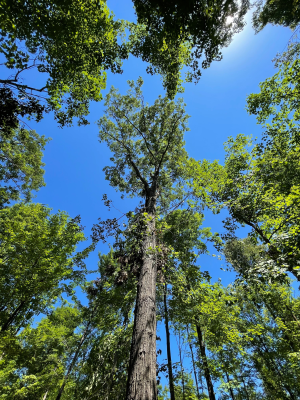Creating Dynamic Wildlife Habitats

With the help of the Conservation Stewardship Program, Barron County landowner Terry Elwood, turns his diverse Moose Ear Creek acreage into a habitat haven for pollinators and wildlife.
Background
In Chetek, Wisconsin, Terry Elwood manages a diverse range of landscapes. He has 95 acres of cropland and owns over 200 acres of forest and wetlands along Moose Ear Creek, a rushing trout stream that flows through southeastern Barron County. Already active in conservation, Terry partnered with the Natural Resources Conservation Service (NRCS) and set out to create a dynamic habitat for wildlife.
Highlights

In 2019, Terry enrolled his cropland in the NRCS Conservation Stewardship Program (CSP). Catering to Monarch butterflies, he converted 19 acres of cropland into a pollinator habitat; planting favorites like milkweed, coneflower, and bergamot, among many others. Despite a slow start and a thistle infestation, dedicated management helped the planting take off. “In order to make this a success, I knew I’d have to stay on top of prescribed mowing,” said Terry. As a result, his acreage is teeming with pollinators. “A successful planting takes at least three years to establish,” explained Barron County NRCS District Conservationist, Pat Richter. “In the first year it sleeps, the second it creeps, and the third it leaps. And this year, it really leaped.”

Terry has continued to partner with the NRCS and enrolled his forestland acreage in CSP as well. He began removing buckthorn, an aggressive invasive plant that suppresses wildlife-friendly shrubs and trees. Beneficial species like hawthorn, hazelnut, and winterberry started thriving in areas of buckthorn removal. On other parts of the property, Terry provided habitats and beneficial resources for wildlife by managing the tree species. In one stand, trees surrounding oaks were thinned to open the canopy for mast production. In another stand, alders were sheared to create an early successional habitat ideal to native bird species.
Future Plans
The conservation practices Terry continues to implement on his property has attracted birds like Golden-Winged Warblers, Woodcock and Ruffed Grouse. He plans to further his conservation efforts through invasive buckthorn removal and prescribed thinning to provide even more permanent habitat for a host of local wildlife.
Additional Information
Conservation Stewardship Program - Wisconsin
The Conservation Stewardship Program (CSP) can help you identify natural resource problems in your operation and provide technical and financial assistance to solve those problems or attain higher stewardship levels in an environmentally beneficial and cost-effective manner.
Learn More

